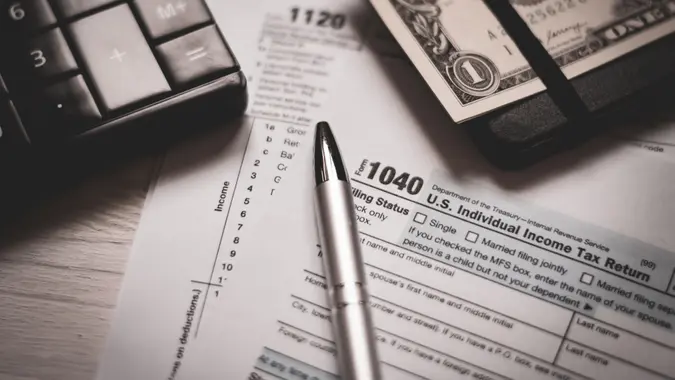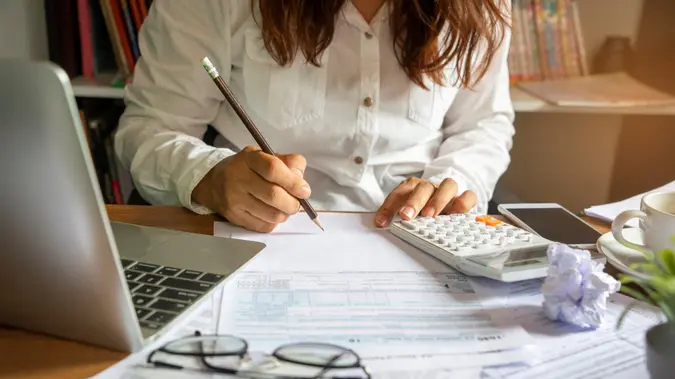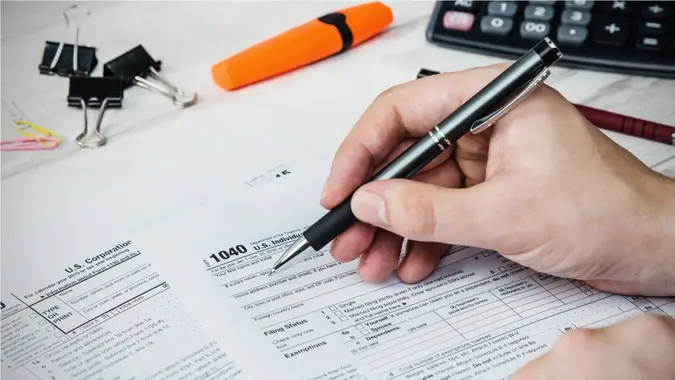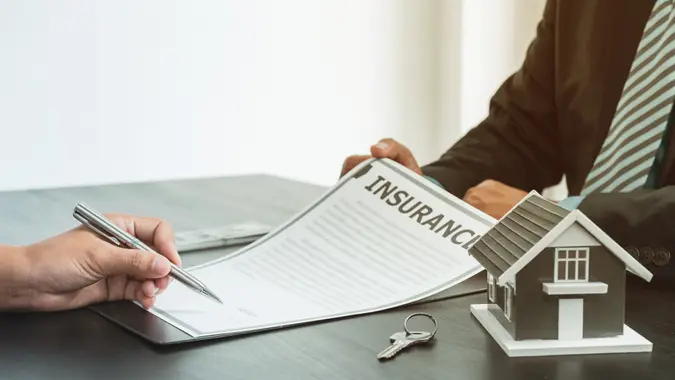Why Most Americans Will Put Their Tax Refunds Toward Credit Card Debt — Should You?

Commitment to Our Readers
GOBankingRates' editorial team is committed to bringing you unbiased reviews and information. We use data-driven methodologies to evaluate financial products and services - our reviews and ratings are not influenced by advertisers. You can read more about our editorial guidelines and our products and services review methodology.

20 Years
Helping You Live Richer

Reviewed
by Experts

Trusted by
Millions of Readers
According to the Wall Street Journal, tax refunds have become a lifeline for many Americans, as debt has grown to epidemic proportions. The Federal Reserve says that debt levels as of the fourth quarter of 2023 were their highest ever, at $17.5 trillion while the New York Fed says that credit card delinquencies are now higher than pre-pandemic levels. If you’re feeling overwhelmed by debt yourself, should you put your tax refund towards your debt? Or are there better options? Here are some of the factors you should consider in terms of your overall tax refund strategy.
Advantages of Using a Tax Refund To Pay Down Debt
It’s unfortunate that so many Americans are in a situation where they have to use their tax refunds to pay down debt. However, it’s a much better option than not paying off debt at all. According to the Federal Reserve Board, the average interest rate for credit card accounts that assessed interest was 22.63% as of February 2024. That’s more than double the long-term average of the stock market, making paying down this debt an excellent use of your funds.
Imagine, for example, that you get a $5,000 tax refund and you have $5,000 in outstanding credit card debt. If you were to invest that $5,000 in the stock market and earn a 10% return, you’d have $5,500. However, at the average 22.63% credit card interest rate, your $5,000 debt would have grown to $6,131.50. In other words, you’d still be $631.50 deeper in the hole than if you had simply paid that debt off with your tax refund. Although this is a simplified example that assumes you make no other payments to your debt, the principle behind it is sound.
How To Prioritize Your Debt
Credit card debt is generally priority No. 1 when it comes to paying off debts, primarily because credit cards are likely to charge you the highest interest rate of any debt you hold. Personal loans, for example, often charge half the rate that you could get on a credit card, while secured funding like auto and home loans typically charge even lower rates. So unless you have a payday loan or work with some type of predatory lender, your credit card debt is likely the thing you want to target first.
Are You Better Off Not Getting a Refund?
As of March 22, 2024, the average refund for tax year 2023 was slightly over $3,000. While getting thousands of dollars of “free money” every year might seem like a great deal, the truth is that money isn’t free at all. It’s simply a return of the taxes you overpaid throughout the prior tax year. In other words, instead of keeping that money in your pocket, you’ve simply loaned it to the U.S. government free of charge. In fact, if you used that money to pay down your credit cards throughout 2023, you might already be out of debt, rather than having to wait to use your tax refund. You could have also avoided months of interest charges by paying down that debt earlier. Regardless of what you did with it, you would have at least been in control of your own money instead of letting the U.S. Treasury use it for free until you got your tax refund.
Tips To Help Reduce Your Debt Load Without Using Your Tax Refund
It can be far too easy to get into the habit of running up debt and then using your tax refund to pay it off. If you’re not careful, that debt could easily run away from you, especially if you don’t receive a refund as large as you are expecting. A better way to approach the problem is to stay out of debt in the first place. If you can simply live within your means, spending less than you earn, debt will never be a problem for you. A good first step is to create a budget that shows you in black and white how much money you earn and where you spend it. A few simple trims here and there on discretionary items like eating out or buying things you don’t really need could really pay off in terms of debt control. Then, if you still receive a tax refund, you can use it for a more productive pursuit, like investing it for your future.
How Investing Your Tax Refund Could Pay Off in the Long Run
Imagine if you can live a debt-free life and invest your $3,000 tax refund every year for a couple of decades. At an average return of 8% annually, that sum would amount to about $147,000 after 20 years, or roughly $872,000 if you continued for 40 years. While not getting a refund at all might still be a better strategy, consistently investing your tax refund can feel like you’re investing “free” money, as it won’t feel like it’s coming directly out of your pocket. And when it comes to investments, any strategy that is effective at getting you to sock money away is a good one.
 Written by
Written by  Edited by
Edited by 

























